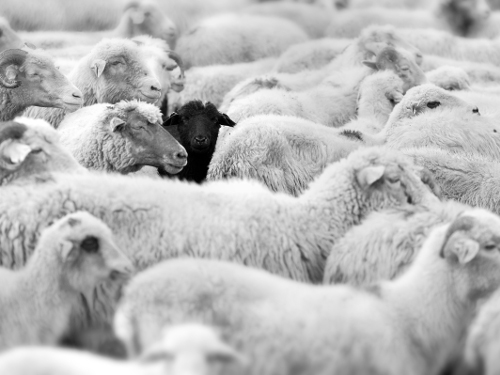Look out for the black sheep
August 10, 2017
| Overview | |
|---|---|
| 2'read | Privileged informant is a well-known pitfall in ethnography, it can happen in user research too. |
When researching user experience for a product or a service, we tend to look for a diversity of perspectives, from the “typical” users, to the most “extreme” ones, whatever the extremes are in a specific area. In the IT context for example, you would have a software engineer ultra-geek at one extreme, and the mythical computer illiterate (grand-)mother at the other end. It could also be in terms of physical abilities, from someone relying entirely on sound to someone relying only on visual cues.

Spotting the black sheep
The black sheep is different. She tends to hide in the indistinct mass of mid-range practices and attributes. What distinguish the black sheep from their peers is not some external characteristics that can be picked up, it’s rather her outlook on things. We all tend to be (white) sheeps: for multiple reasons, both psychological and sociological, we tend to think like our peers. When individuals move from one social circle to another, there is an adaptation phase, but pretty quickly they morph and adopt the ideas and habits of the new circle. Sometimes, this happens so progressively and thoroughly that we don’t even see it happening, except maybe when we meet again with a past acquaintance who still thinks we are like we were. Even then, humans are adept at juggling with different personalities, and might step back into their old roles without even thinking.
The black sheep is the one for whom the fusion is not complete. For a number of reasons, often having to do with very specific circumstances, this user doesn’t share the same common set of beliefs and preconceptions as their colleagues, friends or family. That makes them very valuable for user research, because they are both immerse into the milieu you’re trying to understand, which they know very well, and at the same time separate from it, and able to observe and analyze it from a distance.
They are often quite difficult to identify. You can’t really rely on specific circumstances to screen for them, because they can be any number of things, and there is no guarantee to find one. They are not always outsiders either. They can be perfectly integrated and function very well among their peers. So you might need a little luck to find a black sheep, but you’re more likely to find her if you know what you’re looking for.
Once you’ve found a black sheep, you might be tempted to establish a special relationship. You might be seduced by her outside-the-box thinking, which is likely to be closer to your own point of view. Especially for designers, a shift in perspective can open new design opportunities and stimulate their creativity. She might even have a trove of novel ideas, ready for you to try.
Be wary though of not falling into the well-known (ethnography) trap of the privileged informant. We all have a confirmation bias, and will give more weight to people who share our opinion, or are in a similar position. Though valuable, hers is just another perspective. Be sure to maintain a critical distance with her analysis of the situation and cross-reference ideas with data collected independently.
To make the most of this exceptional user, look out for the black sheep user in two ways: be aware of her possible existence when screening users, double your own vigilance when working with her.